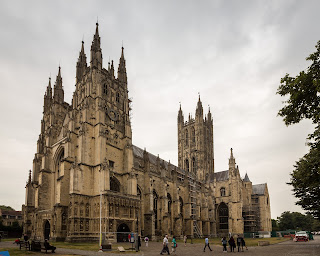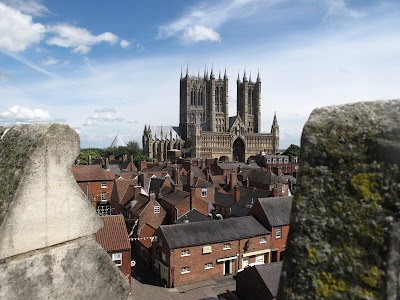The Ladies of the Vale
We've now 'arrived' in Lichfield where on Christmas Day 700 the consecration of the first cathedral here took place and, as there was a church (St Mary's) here perhaps built in 659, and possibly others in between, Lichfield is among the earliest centres of Christian worship in the UK. After the invasion of 1066 the Normans built a new cathedral (of which only a few traces remain), and a century or so later that was rebuilt in the Gothic style, and completed by c.1340.
Besieged three times in the Civil War, it suffered drastic damage, more than any other cathedral. Rapidly repaired in a mere nine years, its interior was rearranged at the end of the 18th century, and then further 'restored' in the 19th century by Sir George Gilbert Scott, and his son Oldrid - that is the cathedral you see in Lichfield today. Outside statues were replaced on the West Front with over 160 ornate carved figures of kings, queens and saints. The cathedral's interior was refurbished with the very fine 'Skidmore Screen', choir stalls and the 'Minton Tiles' (inspired by the medieval tiles on the floor of the Library), which contain a fine example of High Victorian artistry and a very recent relighting scheme means everything can be seen in all its elegant glory.
Lichfield is the only English medieval cathedral to have three spires - known locally as the 'Ladies of the Vale' - it is most one of the elegant in the country.
St Chad came in 669 to be the first Bishop in Lichfield, and so impressive was his teaching and so genuine was the way he practised what he preached, that on his death his remains quickly became venerated and a place of pilgrimage. Among the cathedral's many treasures, from the time of the Anglo Saxons, (probably under King Offa) are the exquisite 8th century sculpture of the 'Lichfield Angel' from the St Chad's tomb chest, as well as the St Chad gospels - perhaps a little younger than the Lindisfarne Gospels but older than the Book of Kells.
During the 18th century the Cathedral and Close flourished and grew in national importance, becoming a centre of culture and learning. With the development of Erasmus, Darwin and his colleagues of the Lunar Society, Samuel Johnson and the great antiquarian, Elias Ashmole, Lichfield became a notable centre. Here was an interesting dynamic with religion and scientific advancement creatively interrelated alongside music, literature and culture, with Lichfield regarded as a major centre of enlightenment within Europe.
As an aside, if you are a Jethro Tull fan, the Grammy-Award winning group is due to play here on Tuesday 2nd December at 19.30 - the concert was postponed from last Christmas.







Comments
Post a Comment